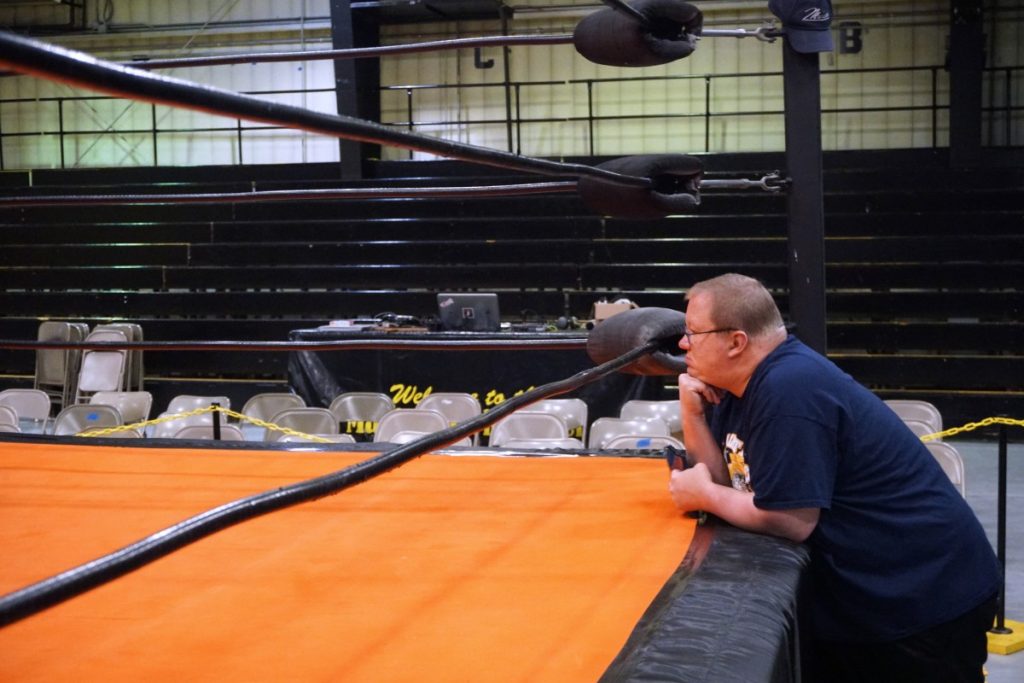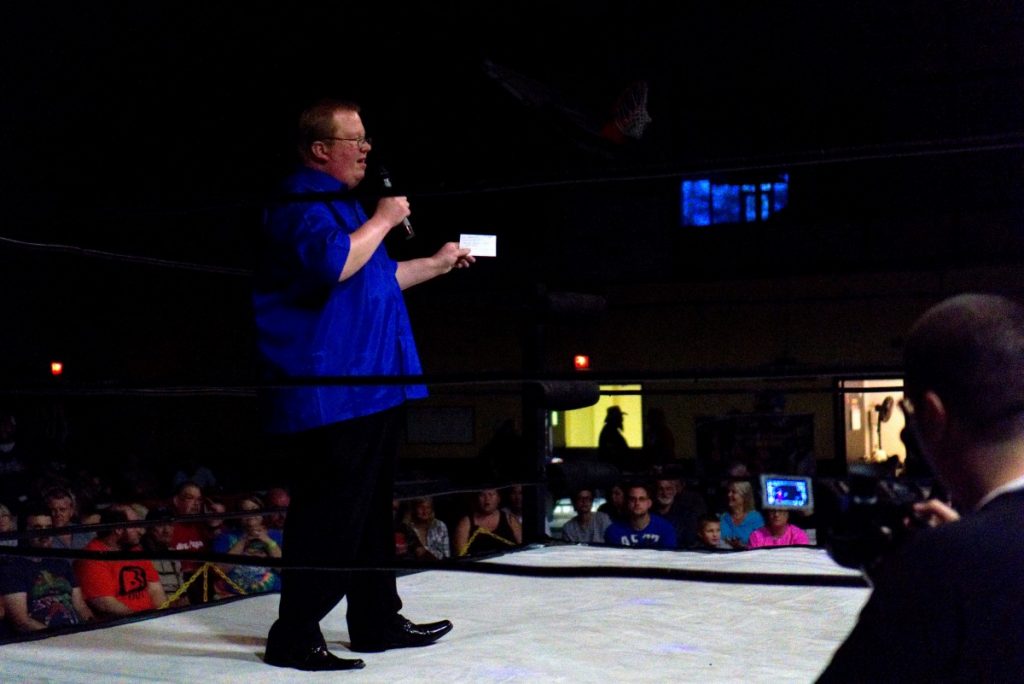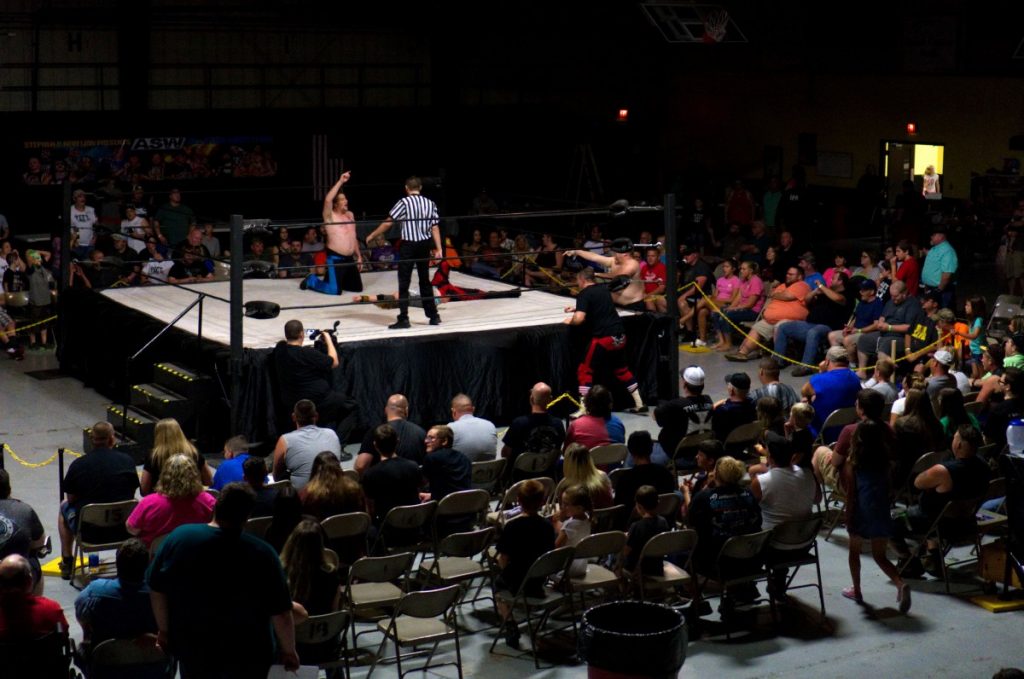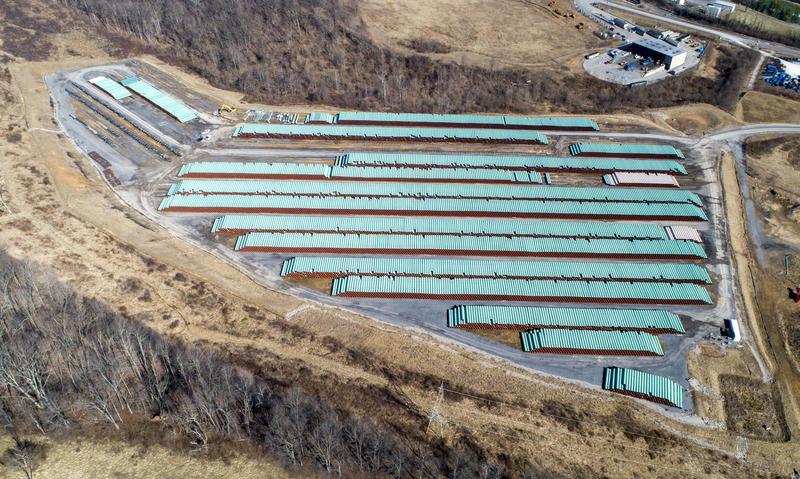The sound of twanging electric guitars fills the Madison Civic Center, a small gymnasium in the heart of southern West Virginia’s coalfields. It’s “Ride Stallion Ride,” the entrance music for WWE Hall of Fame inductee Cowboy Bob Orton.
The 300 fans seated on folding chairs and wooden bleachers during this May 2018 show clap and cheer as they wait for the wrestler to appear from behind the black polyester curtain. But the Orton that finally emerges is not the young, scowling, curly-haired villain pictured on the posters for tonight’s show. It’s not the big dumb oaf who, during the inaugural Wrestlemania in 1985, accidentally whacked his pal Mr. Wonderful Paul Orndoff on the head to give Hulk Hogan an easy pin.
The fringe vest and Stetson are the same. So is the prominent nose. But this white-haired, 70-year-old version of Cowboy Bob Orton has a keg where decades before a six-pack used to be. Yet his feet are light as he trots to the ring with Louis Moore, his tag-team partner for the night. He scales the ringside steps and swings his body through the ropes, then jogs slowly around the ring as the ring announcer introduces his opponents.
Now it is Fall Out Boy’s “Centuries” blaring from the speakers. The good guy tag team O.V.E.R. appears from behind the curtain. Skinny, pale and dressed in black, Christian Kobain and Shane Kryzak look like members of a heavy metal cover band. They strut down the aisle, jump into the ring and mount adjacent turnbuckles to flex for their devotees — the majority of whom, from the sound of the squeals, seem to be women.
The referee checks everyone’s boots and signals for the bell.
If you’ve ever seen a tag team match, you can guess how this will go. Orton and Moore spend much of the match abusing Kobain while keeping him safely out of Kryzak’s reach. When the battered babyface finally gets to his corner and makes the tag, his comrade explodes into the ring — only to promptly fall into Moore and Orton’s clutches. For a moment, it looks like the bad guys will win. Orton goes for an RKO, a neckbreaker finishing move made famous by his son and fellow WWE superstar Randy Orton. But at the last second, Kobain reaches into the ring and pulls Kryzak from Orton’s grasp.
This destabilizes the big cowboy. He stumbles and falls to the mat. Both members of O.V.E.R. dogpile onto his hefty frame. The referee flops on his belly and pounds the mat with an open palm. One. Two. Three.
The ref signals for the bell and Fall Out Boy again fills the gymnasium, the emo pop mixing with shouts from fans. But instead of cheering the victorious good guys, the crowd sing-songs at Orton.
“YOU STILL GOT IT!” clap clap clapclapclap “YOU STILL GOT IT!” clap clap clapclapclap “YOU STILL GOT IT!”
Moore grabs a microphone and accosts Orton for losing the match. “All these people out here say ‘You still got it.’ From what I saw here tonight, you don’t have it anymore old man.”
The fans begin chanting again. “R-K-O! R-K-O! R-K-O!” In a flash, Orton locks his arm around Moore’s head and drops to the mat. Moore flops on the canvas like his spine has been separated from his brainstem. Now Orton’s music is blasting through the sound system.
The crowd erupts with a fervor usually reserved for tent revivals and championship football games. Grown men leap to their feet in ecstatic applause. Preteen boys in basketball shorts move to the aisle to slap Orton’s hands before he disappears behind the curtain. This is something they might tell their own preteen boys about someday, the night they saw Cowboy Bob Orton administer an RKO at the Madison Civic Center.
Little do fans realize that Gary Damron, who has promoted wrestling shows like this for the last 14 years under the name All Star Wrestling, has worked for months trying to bring this moment to fruition — and he saw almost none of it. Damron spent the majority of Orton’s match hidden away in the civic center’s kitchen, stuffing cash into white envelopes to pay his wrestlers.

Many wrestling promoters are former wrestlers themselves. Damron is not. He is a short, soft-spoken, soft-bodied, spectacled midnight shift movie theater custodian with plantar fasciitis. He loves All You Can Eat Wings Wednesdays at Quaker Steak & Lube, his dachshund Chico, and ’80s pop culture — especially The Golden Girls. He has no interest in administering or receiving a drop kick, frog splash, figure four, or piledriver. He has too much work to do.
With his envelopes filled and his stack of greenbacks much slimmer, Damron slips from the kitchen into the noisy gymnasium. He’s just in time to see Orton RKO Moore. He ducks into the backstage area, catching Orton just before he heads to the subterranean locker room. Damron hands him an envelope containing $700 and Orton nods his thanks. Then the cowboy descends the stairs, and Damron goes back to work.
He won’t see much of the rest of the show, either. He will not see Impact Wrestling star James Storm go toe-to-toe with ASW’s favorite heel Shane Storm, and he will only catch a short glimpse of the ASW Heavyweight Championship match between his best friend Rocky Rage and Chase Owens, of New Japan Pro Wrestling’s popular Bullet Club faction. There are too many other things demanding his attention.
The ticket booth needs change, so he hustles to the concession stand to get more. Then the concession stand runs out of pizza, so he calls Gino’s Pizza & Spaghetti House, orders five more, and pays the ponytailed delivery girl from the vinyl bank bag he keeps tucked under one arm. When James Storm raises a dispute over how much he is to be paid, Damron whips out his iPhone to remind the star of their agreement — $1,500 cash, but ASW will keep the revenue from his autographs and photos.
He handles these hiccups with grace, but they take an emotional toll on Damron. Like a cruiserweight perched on the top turnbuckle, he knows even the smallest miscalculation could turn disastrous. His promotion operates in one of West Virginia’s most economically depressed areas, and his fans spend significant portions of their limited incomes at his shows. If the shows stop being worth the $13 per ticket Damron charges, the folding chairs will be empty.

But the folding chairs are far from empty, and Damron’s hard work does not go unnoticed by fans. Before and after shows, they constantly approach Damron for hugs and selfies. And when he climbs through the ropes just before intermission to make some announcements, he gets a chant of his own: “THANK YOU GA-RY. THANK YOU GA-RY. THANK YOU GA-RY.”
Damron discovered wrestling the way most fans seem to — while flipping through the channels on his parents’ TV.
It started with Hulk Hogan’s Rock ‘n’ Wrestling, a short-lived 1980s Saturday morning cartoon featuring the Hulkster and other WWF characters. Not long after, Damron came across an actual wrestling broadcast. “I was like, that’s Paul North! Jimmy Snooka! Andre the Giant! Junkyard Dog! That’s a cartoon that I watch on Saturday morning! I didn’t realize these were real people.” Damron was soon such a fan that, when his mother needed to punish him, she would threaten to take away his wrestling programs.
But it wasn’t Hulk Hogan that inspired Damron to get into show business. It was God.
Damron’s church regularly hosted southern gospel singing groups. He fell in love with the music’s harmonies, tasteful country-style instrumentation and lyrics that tell stories and touch hearts. When he was 17, he decided to bring one of his favorite singing groups to his church. Damron convinced the women of the congregation to organize a hotdog sale and raise the group’s $500 booking fee. He printed up some posters and hung them around town. The concert drew a packed house. The group, pleased with the turnout, encouraged Damron to keep promoting concerts.
This was the mid-1990s, the heydey of the southern gospel scene. Damron’s concerts were soon packing out venues across southern West Virginia. He saw his name mentioned alongside the nation’s top promoters in The Singing News, southern gospel’s magazine of record. It was a heady experience.
“I never did anything successful. I was a nerdy kid, quiet,” Damron recalled in one of our lengthy middle-of-the-night phone interviews, during which he took out the trash and swept the floors at the movie theater while I tapped out notes at my kitchen table. “When you have a little bit of success — it can make you egotistical.”
Damron’s title reign did not last long. By the early 2000s, southern gospel’s popularity was waning. Churches — and, more importantly, Christian radio — were moving toward modern styles of music to appease younger believers. Damron struggled to sell enough tickets to pay the singers. But he developed a system for dealing with these embarrassing situations.
He would write the band a check for the full amount owed, making clear the check would bounce if they tried to cash it. It was only supposed to be a form of security: Damron promised to make payments until his debt was cleared. “Most of the time groups didn’t have a problem with that. I did it for a long time,” he says. “Then it started catching up to me.”
In June 2003, Damron booked a concert in Prestonburg, Kentucky. It cost about $4,000 to book the singer and venue. Only about 75 people showed up. Damron made his usual promises and wrote a bad check for security. The singer agreed to the deal but the man’s wife later called the West Virginia State Police.
A few months later, Damron wrote another bad check after another low-performing concert. The singers tried to cash the check. Since Damron was already under investigation for the Kentucky concert, this immediately got the attention of the local prosecuting attorney. He was charged with issuing worthless checks and indicted by a grand jury. Damron was now facing up to 10 years in prison.
One day, as Damron waited for his April 2004 plea hearing, he was again flipping through the channels when he happened across an episode of The 700 Club featuring “The Million Dollar Man” Ted Dibiase. The wrestler spoke about his Catholic upbringing, his rise to fame and his fall from grace through substance abuse and infidelity. But Dibiase had rediscovered his faith and retired from the wrestling ring. Now he traveled the country preaching God’s word.
At the end of the segment, Dibiase’s number flashed on the screen. Damron called and left a message. A few days later, Damron answered his phone and heard a deep baritone on the other end: “Hello Gary, this is Ted Dibiase.”
Damron was starstruck. But when he finally regained his faculties, he explained he wanted to book Dibiase to speak at one of his concerts. He also wanted to stage a Christian wrestling event that would culminate in a come-to-Jesus altar call. Dibiase put Damron in touch with George South, a WCW veteran and fellow devout Christian who would provide the wrestlers and the ring. Damron would only need to supply the money, book the venue and handle promotion.
Damron reserved all four conference rooms at Chief Logan State Park’s conference center in Logan, West Virginia. He placed an item in the Charleston Gazette’s “Church Activities” column, where the announcement for his religious wrestling show ran alongside notices for church dinners, a play about the life of a “humble missionary in China in the late 1800s” and a sermon by an evangelist who had recently preached in Saddam Hussein’s former palace in Iraq.
But as the show drew closer, South advised Damron against the Christian angle.
Although never one to hide his faith under a bushel — South regularly autographs copies of the New Testament to give to fans — he told Damron running a faith-based program might scare off audience members who came expecting a regular pro wrestling show. Damron decided South was right. No sermons or altar calls. Just wrestling.
More than 200 people showed up. They cheered as Greg “The Hammer” Valentine went up against Scotty McKeever, a West Virginia native who had a brief WCW career. They laughed as the aging National Wrestling Alliance legend Jimmy Valiant worked a quick comedy match with one of South’s wrestling students. But they saved much of their enthusiasm for the main event.
South and WWF alum The Barbarian came out with Dibiase, their manager for the evening. Then the clanging drums of Electric Light Orchestra’s “Rock ‘n’ Roll is King” filled the conference room.
Damron watched the receding mullets of Robert Gibson and Ricky Morton — the Rock ‘n’ Roll Express — make their way to the ring. He felt like he was hallucinating. “It’s like you have somehow escaped reality and you’ve gone into this fantasy world. These are the people I watched on TV. These were my heroes growing up.”
But for Damron, it was more than an escape. It was a way forward.
On April 16, 2004, the front page of Damron’s hometown newspaper blared: “Gospel promoter pleads guilty.” The paper ran his promotional headshot — the one he had used for gospel concert advertisements — beneath the bold letters.
Because Damron had no previous criminal record and had already repaid all his outstanding debts, the judge sentenced him to only 48 hours in jail and four months on home confinement, followed by two years’ probation.
The public was not so merciful. When he walked around Walmart, he noticed people whispering and casting sideways glances. The details of his crimes became twisted in their imaginations. “I’ve had people say, ‘Didn’t you get in trouble for stealing money from a church?’”
Once, Damron decided to go see one of his old favorite gospel groups at a concert in his hometown. As soon as he walked in, a man caught his eye. “Look here, honey!” the man said to his wife before turning back to Damron. “When’d they let you out?”
The joke, inane as it was, crushed Damron. He slipped into a seat in the balcony and began to cry. “God, I came here tonight thinking this would be some kind of healing for me,” he prayed. “And the devil already ruined it.”
The treatment he received at the hands of Christians soured Damron against church. He no longer felt welcome in the gospel music community. But that was fine. Damron had found another community that didn’t seem to care about his past.
In August 2005, Damron and some friends traveled to Charlotte, North Carolina, for the NWA Wrestling Legends Fanfest. Damron was surprised by how easy it was to get the wrestlers’ business cards. “In gospel music, you have to go through an agency in Nashville,” he says.
Wrestlers were cheaper than gospel singers, too. While Damron had paid thousands of dollars for middling singing groups, he could hire his childhood heroes for a few hundred apiece.
Damron decided to organize his own miniature fan festival that December. He booked the Midnight Express and their manager, Jim Cornette, for an appearance at Pikeville College in Pikeville, Kentucky. He thought fans would be excited to take photos, get autographs and chat with the old-timers. He was wrong.
Only about 30 people came — and they came expecting a fight. “Here we are, in an auditorium, and people were coming in saying ‘Where’s the ring?’” Damron says. He had to refund the tickets of a deaf family who, like others, came expecting a wrestling match but, unlike the rest, wouldn’t get much from a panel discussion.
Damron lost thousands of dollars on the event, but it taught him an invaluable lesson.
“Everybody told me, ‘If you want to do something like this, you’ve got to have live matches.’”
Easier said than done.
Other than the show South had organized for him, Damron had no experience booking a live wrestling show. But he called up a local independent wrestler he’d met by chance — his wrestling promotion happened to be using the same building as one of Damron’s gospel concerts — and together they built a card that included local wrestlers as well as WWE stars Buff Bagwell, Billy Gunn, Jon Heidenreich and Mordecai, among others. Damron promoted the show under the intentionally old-fashioned-sounding moniker “All Star Wrestling.”
The inaugural ASW show took place on a Sunday afternoon in March 2006 at the Williamson Field House in Mingo County, which sits just across West Virginia’s border with Kentucky. About 200 fans showed up. Buoyed by the response, Damron booked another show at the fieldhouse five months later. This one was a hit, too. Audiences continued to grow larger as word spread about Damron’s habit of booking big-name wrestling stars. In little more than a year, he had built the most successful wrestling promotion in West Virginia.
There was only one problem. Damron was bankrolling most of ASW’s operations by working two jobs in Logan: managing a Pizza Hut in the evenings and immediately heading over to clean the Fountain Place Cinema 8 at night. It eventually became too much. He quit Pizza Hut and started running ASW on a tighter budget. He still brought in big names, just not as many as before. But this, combined with a downturn in West Virginia’s coal industry, drove down ticket sales.
Damron was back in familiar territory, putting on shows that didn’t make enough money to cover expenses. It was during this time that wrestler Vance Desmond got booked to wrestle on an ASW show in Madison. Only a few dozen fans showed up. At the end of the night, Damron told the wrestlers he couldn’t pay them that night but promised to make it good. Desmond doesn’t remember how much he was owed — maybe $30 or $40 — but he had been around wrestling promoters long enough to know Damron was full of it. “I thought, ‘I’ll never see that money,’” he says.
A couple weeks later, Desmond was working for a different promotion in Huntington, West Virginia. Just before the show started, Damron appeared out of nowhere, which was a surprise since Damron does not drive and the show was about 70 miles from Logan. He handed Desmond his money, just as promised, chatted for a minute and disappeared into the crowd.
Desmond, who has retired from wrestling but now runs a gym and wrestling school in Parkersburg, West Virginia, told that story when Damron inducted him into the ASW Hall of Fame in April 2018. “That’s what kind of promoter Gary Damron’s been,” he said. “That’s not something you see. Ever.”
It took a few years, but ASW eventually rebounded. Damron’s shows now draw some of the biggest crowds in West Virginia’s independent wrestling scene.
Why? Ask ASW’s predominately male, and middle-aged fans, and you get some variation of the same answer: “He books the wrestlers I liked when I was a kid.”
That’s partly right. Damron was booking WWE legends like Ron Simmons, Paul Bearer and Jimmy Hart even in the bad old days, but the starpower has increased significantly in recent years. Damron held a meet-and-greet with Ric Flair and Ricky “The Dragon” Steamboat in 2015 and, in 2017, hosted The Hardy Boyz during their quest to become “the greatest tag team in all of space and time.” The latter was included in a nationwide TNA broadcast.
But those achievements are just markers of Damron’s success, not reasons for it. Whether fans realize it or not, the big names are not what makes ASW work. It’s not what keeps people coming back to the Madison Civic Center month after month.

The thing that sets ASW apart — and saved it during the lean years — is Damron and his wrestlers’ ability to tell a really good story.
This was not a skill Damron has always possessed. In his early days as a promoter, he booked matches on the fly. He just looked around the locker room and decided which wrestlers would share the ring. But even as he struggled to make ends meet, he learned to create grudges and rivalries that spun themselves into multi-show storylines.
Now, Damron views each year like one season of a television show. He knows where his characters will be at the season finale, and knows he has seven or eight shows to get them there. When he brings in stars, he often finds ways to use them to advance these storylines.
But it isn’t just Damron who shapes these story lines. Fans get their say, too. If a wrestler connects well with audiences — this is called ”getting over,” in wrestling jargon — that wrestler will often find himself featured in high-profile matches.
Over the years, no ASW wrestlers have gotten over more than Rocky Rage and Shane Storm. It’s easy to see why. Neither is afraid to take physical risks, which have resulted in dislocated fingers, loosened teeth and at least one compressed spine. And both are more than willing to take creative risks, especially when given the opportunity to demolish the distinction between fiction and reality.
One night, Storm was delivering a merciless beatdown on another ASW wrestler when Rage, who had just returned after six months in Texas, sprinted to the ring to stop the assault. For his trouble, Storm busted his head open with a folding chair. That’s when Rage’s wife, Jamie, jumped into the ring to stop the fight.
ASW fans knew Jamie well. Wrestlers’ wives and girlfriends can often be seen filling nacho trays at the concession stand or helping visiting superstars run their merch tables. So it’s easy to understand their shock when, instead of heeding her pleas, Storm gave Jamie a boot to the face.
Adding to the audience’s confusion, Rage grabbed a microphone. “This isn’t Rocky Rage talking to Shane Storm. This is Rocky Hardin talking to Matt Wolfe,” he hollered, breaking wrestling code by using their real names. “And I’m going to kick your ass.”
He dropped the mic and chased Storm into the locker room. Fans gave chase, too. As did the police.
The civic center sits beside the Madison Police Department, so officers often hang out at Damron’s shows while waiting on calls. When Storm kicked Jamie, “there was such a great feeling of shock and disbelief that the cops felt it was real,” Damron says. It took some time to explain it was all part of the story. Even then, the officers were still upset. “They said, ‘When you do something like that, you’ve got to let us in on it!’” says Dustin Dent, ASW’s locker room manager.
But Damron and company continued to lean into the shock factor, spinning the fight into an intense rivalry between Storm and Rage, which culminated in Rage reclaiming the heavyweight title at the promotion’s 10th anniversary show in April 2016. “People were really invested in their story. All of it kind of clicked,” Damron says.
The final bell has sounded. Damron stands near the door as fans leave. “Good show,” says a big-bellied man in a faded t-shirt, patting Damron’s shoulder. “We’ll be back,” says someone else. The compliments keep coming. “Another great show, Gary.” “We’ll be back.” “That was a really good show.”
Once everyone is gone, the folding chairs are stowed away and the leftover pop bottles and candy bars are safely secured in a closet, Damron leaves the civic center for the first time in 10 hours. It’s time for his favorite part of the night: dinner at Quaker Steak & Lube.
The restaurant—a franchise bar and grill made to look like a midcentury gas station on the outside and decorated with car parts, neon and vintage-looking signs on the inside—is nearly empty, save for the ASW crew. The guys from O.V.E.R., still giddy from their match with Orton, are pounding shots of Fireball. Shane Storm, seated with his very pregnant wife, is cracking jokes and telling war stories about wrestling in Mexico.
Damron walks in and finds a seat at the end of the table, across from Dent. They talk through the night’s show, what got over with fans and what didn’t. Dent tells Damron how things went in the locker room. And, though the civic center’s halogen lights have barely started to cool, they begin to talk about the next show.
Later, during another late night phone interview, Damron wonders if he’s spent too many years focused on wrestling. He wonders if he’s let more important things slide. He wanted to be married and have kids by now, wanted to have a good job that would allow him to take care of his aging parents.
I ask if he thinks about giving it up. He takes no time to ponder his answer. No. “It’s hard to explain. You love it so much,” he says.
Damron is hardly the only one under wrestling’s strange spell. Consider Orton, who has tasted the highest heights of wrestling fame but is still out on the road, wrestling in front of a few hundred people in small towns across the country well into his seventh decade of life. Or men like Rage and Storm, who work responsible “shoot jobs” during weekdays but grind their bones to dust on nights and weekends, often for less than a tank of gas.
It might be difficult for Damron to explain his attraction but, from the outside looking in, it’s pretty clear. For all the work and worry that wrestling causes him, it has also given him friends he might not otherwise have. It has given him an opportunity to rub elbows with heroes who once lived only inside his parents’ TV. But, more than all that, it has provided him a way to overcome his past mistakes, repair his reputation and gain the adulation of hundreds of fans—to turn from heel to babyface in the mind of his community.
How could he ever get over that?



